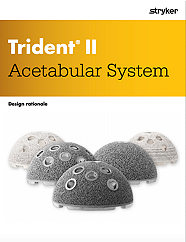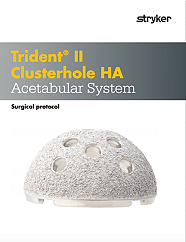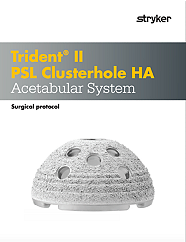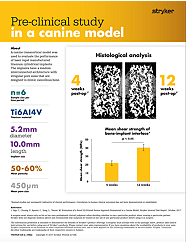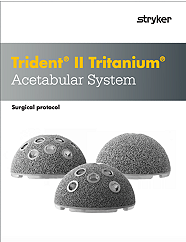Trident II
Acetabular System
Have confidence in a powerful combination–a system that builds on the legacy that has defined our Trident brand for more than two decades, paired with the latest additive manufactured Tritanium In-Growth Technology or PureFix HA.
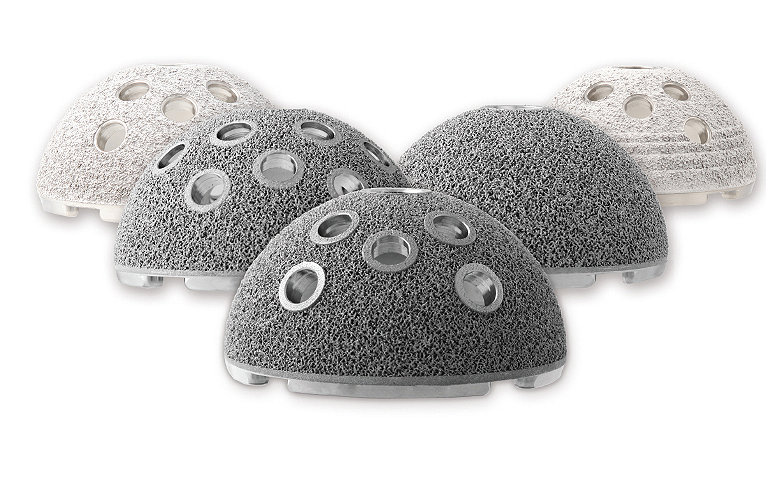
Built on what works
The Trident II Acetabular System builds on the legacy that has defined Stryker's Trident brand for more than two decades. Consistently one of the most implanted brands in the Australian1 and UK2 National Joint Registries, the Trident shell also demonstrated the lowest revision rate at the longest follow-up among uncemented shells in both registries.1,2
The legacy of the Trident brand is reinforced by clinically proven3-5 bearing options enabled through the Innerchange Locking Mechanism, such as Modular Dual Moblity (MDM) and X3 precisely engineered polyethylene.
Trident II is built on data from the largest joint registries in the world,1,2 international performance ratings,1,2 and premier global publications.
Creating what’s next
Trident II Tritanium builds on the experience we have gained from the additive manufactured implants in our knee and spine portfolios. Additive manufacturing allows us to challenge conventional implant design and production, unlocking implant features such as a Tritanium surface comprised of a controlled network of pores designed to mimic the complex characteristics of cancellous bone, to address clinical considerations such as fixation and stability.
Streamlined trays complement new intuitive instruments which are designed to facilitate efficient and accurate bone preparation and implantation. Additionally, the Trident II System is Mako-enabled, combining the reliability of additive manufactured implants with the precision6 of robotic-arm assisted surgery.
18-year revision rate obtained from table HT12 in AOANJRR 2019 annual report1
| Femoral component |
Acetabular component |
N revised |
N total |
1 year |
3 years |
5 years |
10 years |
15 years |
18 years |
| Secur-Fit Plus |
Trident (Shell) |
208 | 6021 | 1.3 (1.0,1.6) |
1.9 (1.6, 2.3) |
2.4 (2.0, 2.8) |
3.4 (2.9, 3.9) |
4.7 (4.0, 5.4) |
5.1 (4.3, 6.1) |
15-year revision rate obtained from table 3.9 in UK National Joint Registry2
| Stem/cup brand |
N | Median (IQR) age at primary |
% |
Cumulative percentage probability of revision (95% CI) at: | |||||
| 1 year | 3 years |
5 years |
7 years |
10 years |
15 years |
||||
| Exeter V40/ Trident |
84,865 | 69 (61-76) | 40% | 0.59 (0.54-0.64) |
1.06 (0.99-1.14) |
1.43 (1.33-1.53) |
2.59 (2.40-2.79) |
3.38 (3.05-3.75) |
4.05 (3.23-5.09) |
References:
- Australian Orthopedic Assocation national Joint Replacement Registry, 2019 Annual Report.
- UK National Joint Registry, 2019 Report.
- D’Antonio J, et al. Second-Generation Annealed highlight Crosslinked Polyethylene has Low War at Mean Seven Year Follow-up. Surgical Technology International 2014 Nov;25:219-26.
- Jauregui J, et al. Dual Mobility Cups: an Effective Prosthesis in Revision Total Hip Arthroplasties for Preventing Dislocations. Hip Int. 2016 Jan-Feb;26(1):57-61.
- Su E, et al. The Role of Constrained Liners in Total Hip Arthroplasty. Clin Orthop. 2004;420:122-129.
- Elson L, Dounchis J, Illgen R, Marchand R, et al. Precision of acetabular cup placement in robotic integrated total hip arthoplasty. Hip Int 2015; 25(6):531-536.
TRIDII-WC-3_23945

